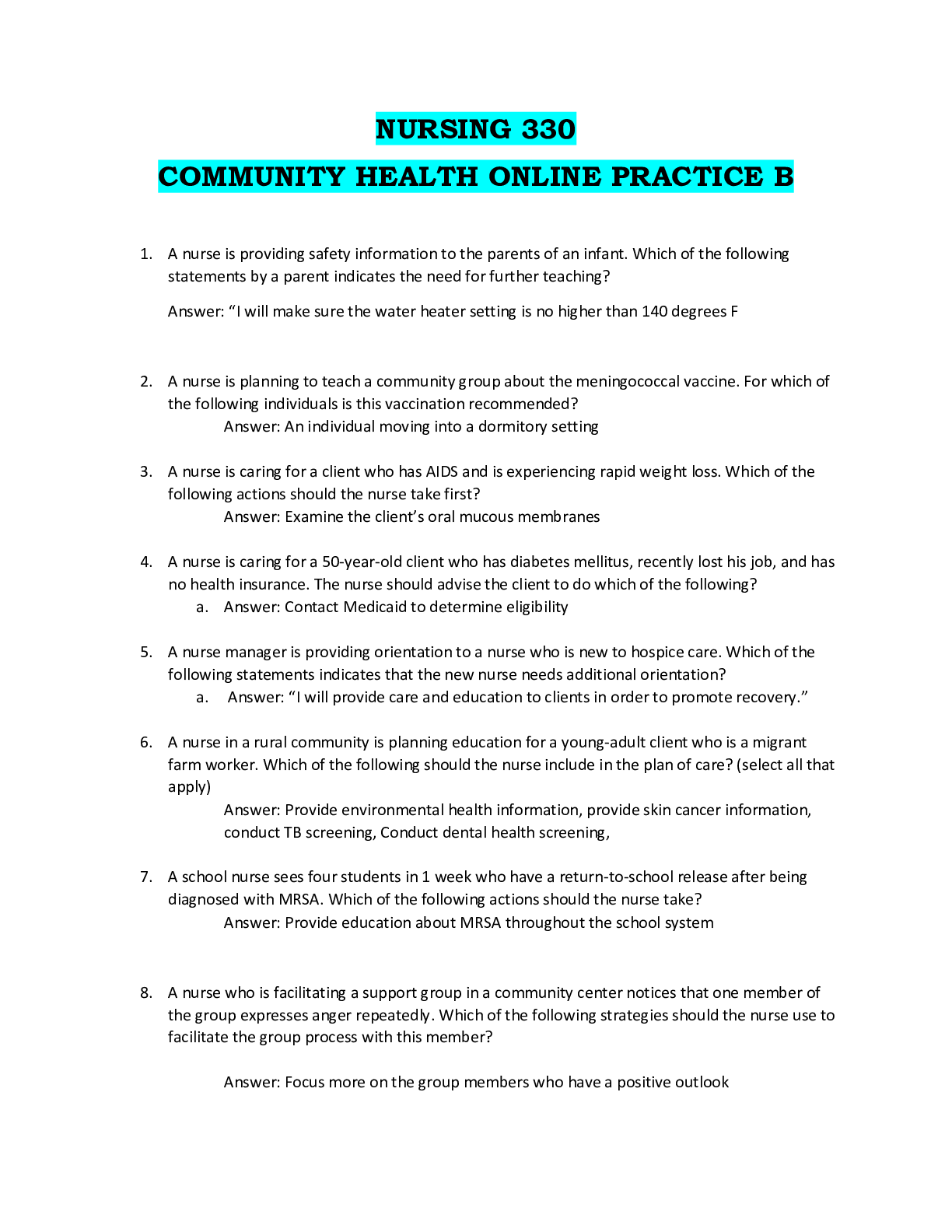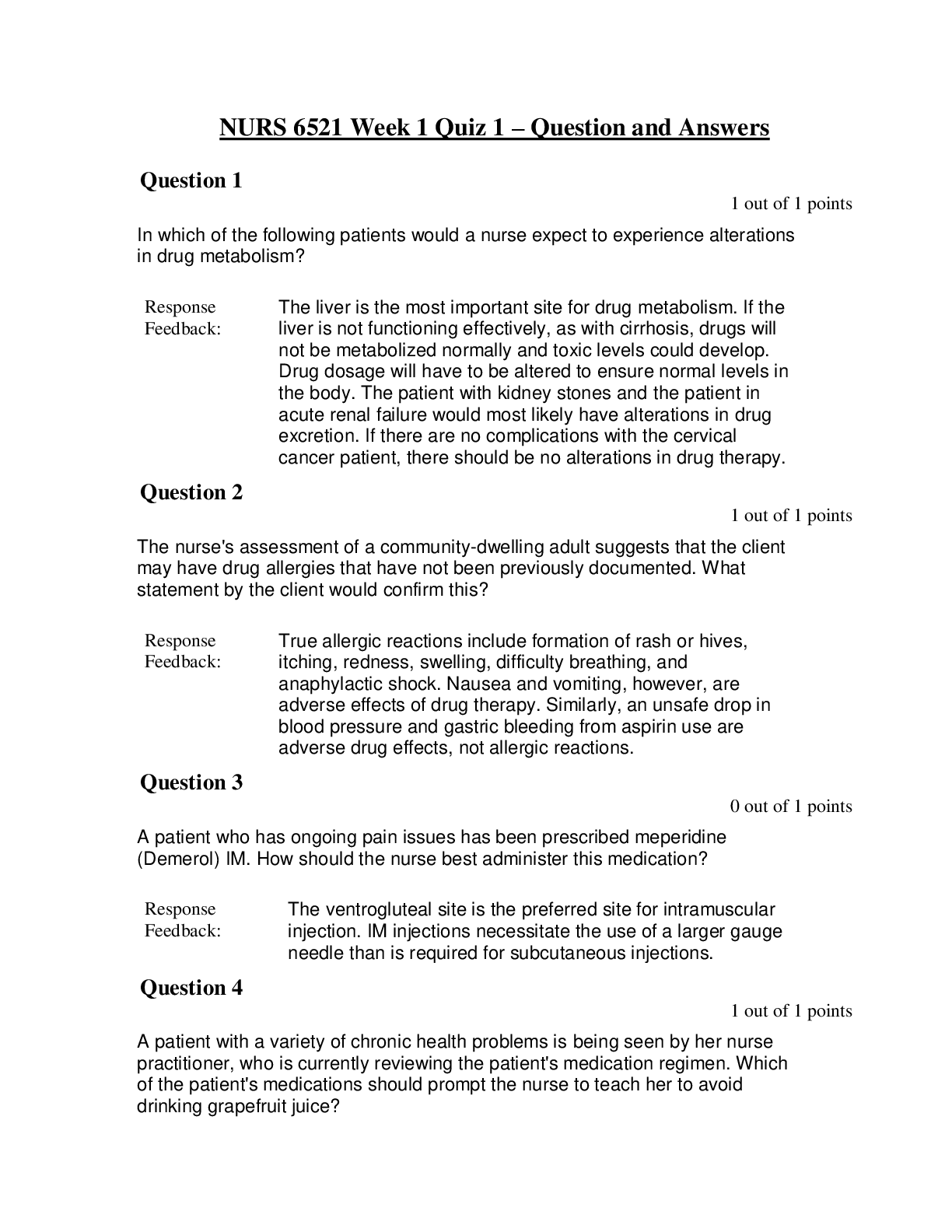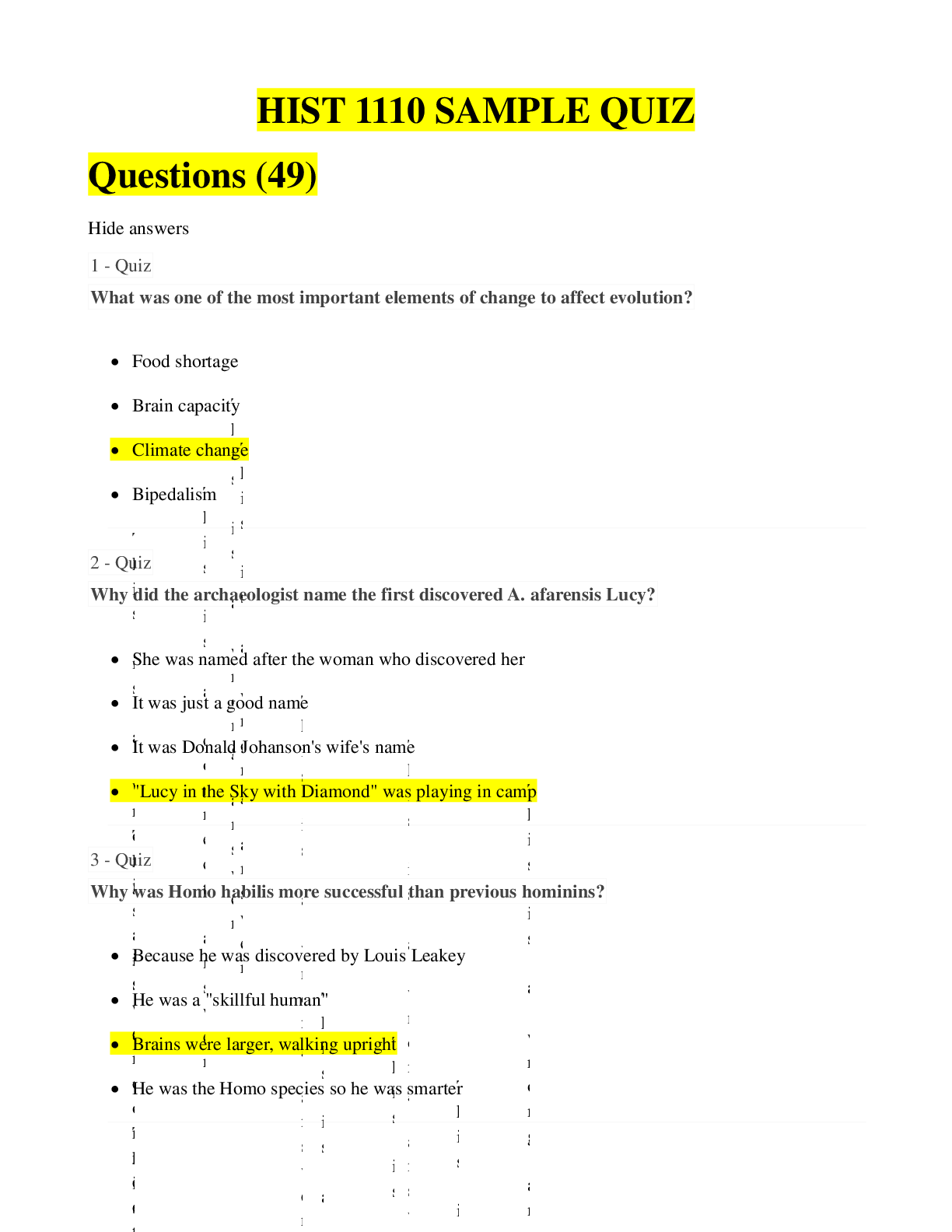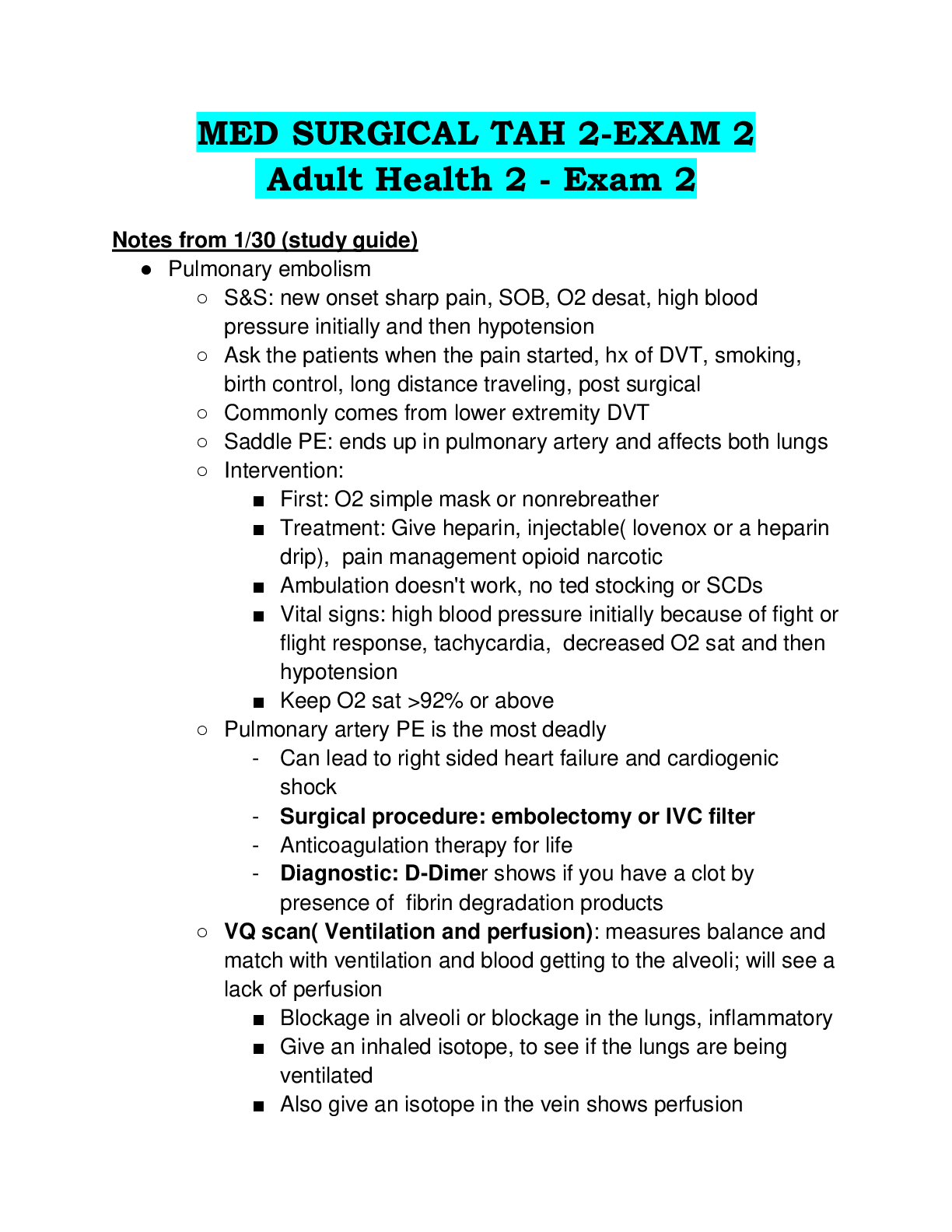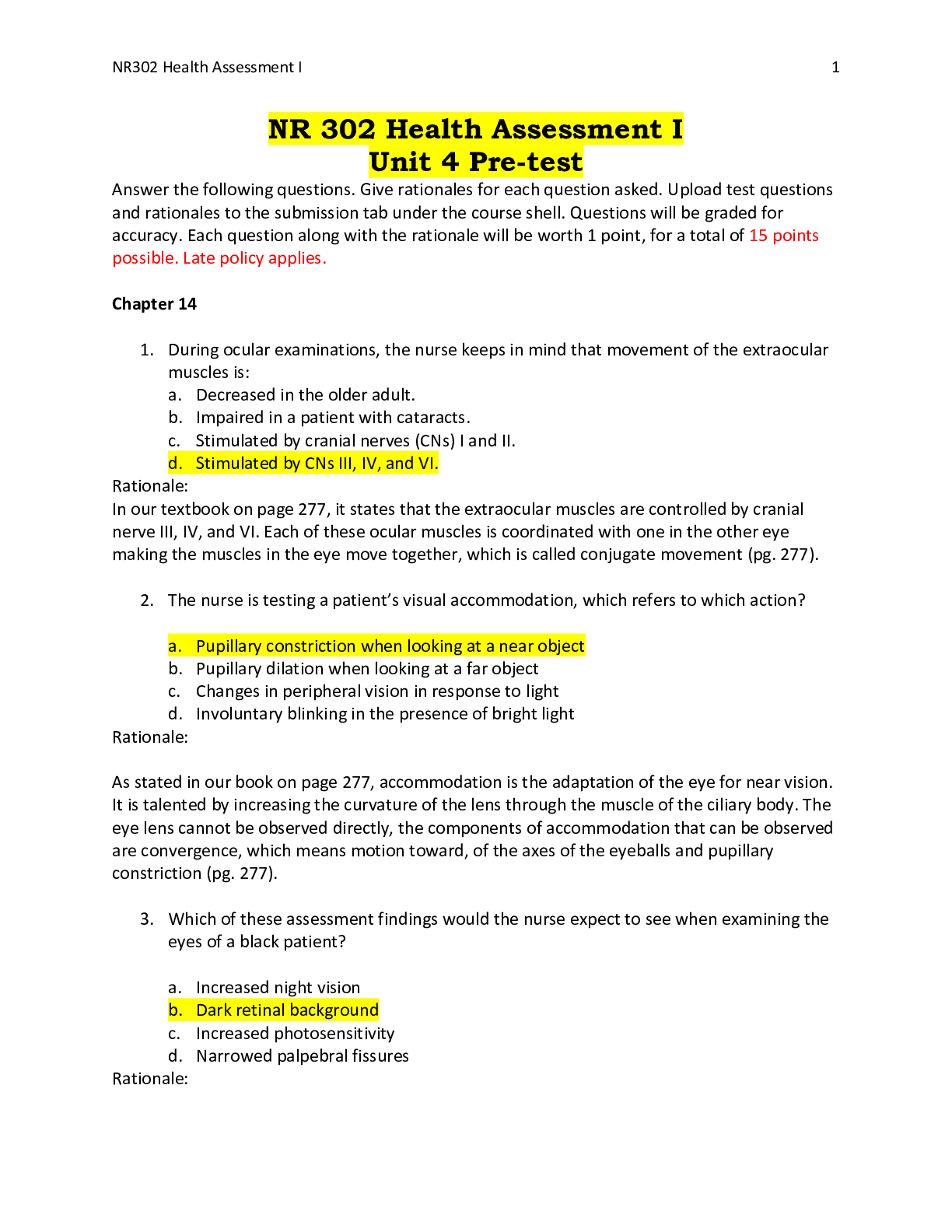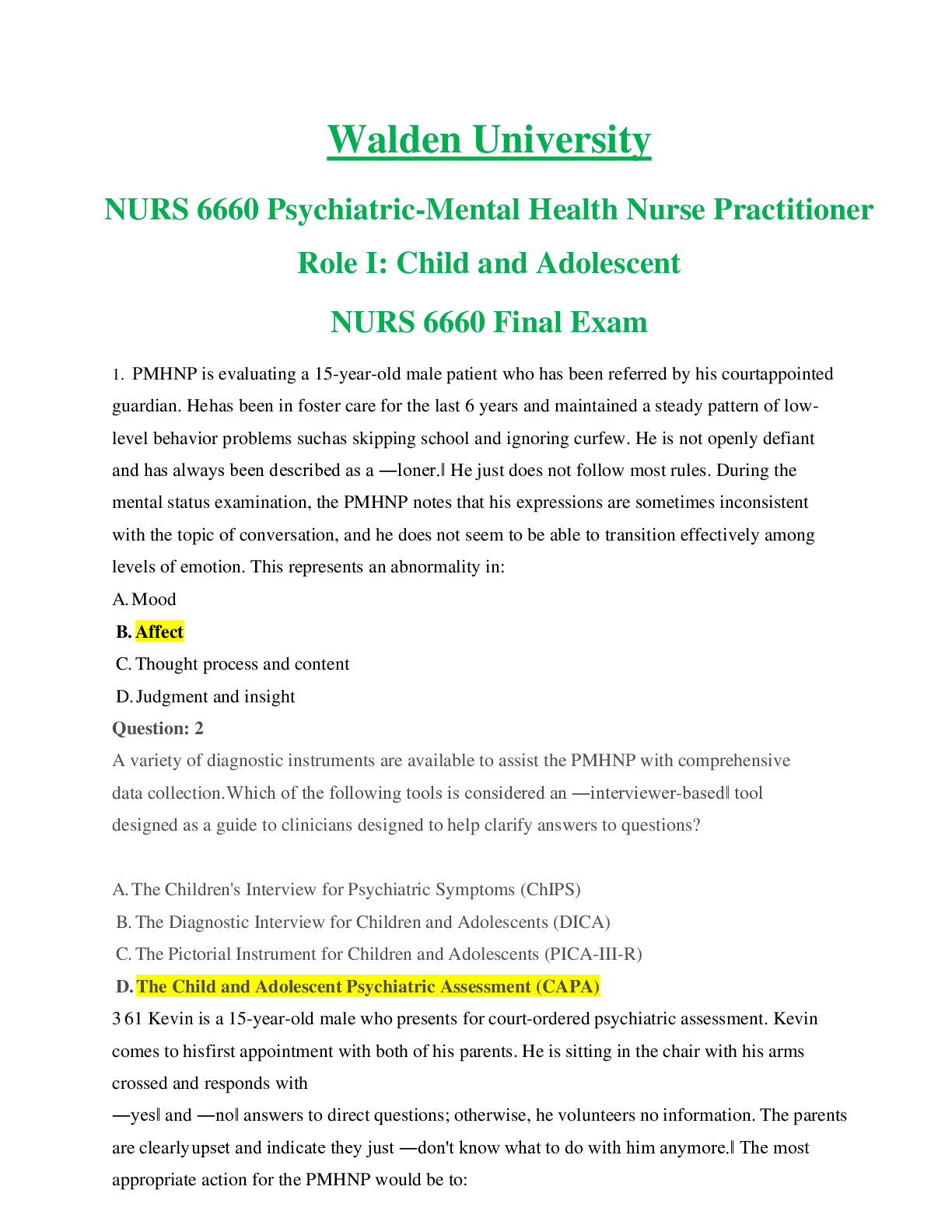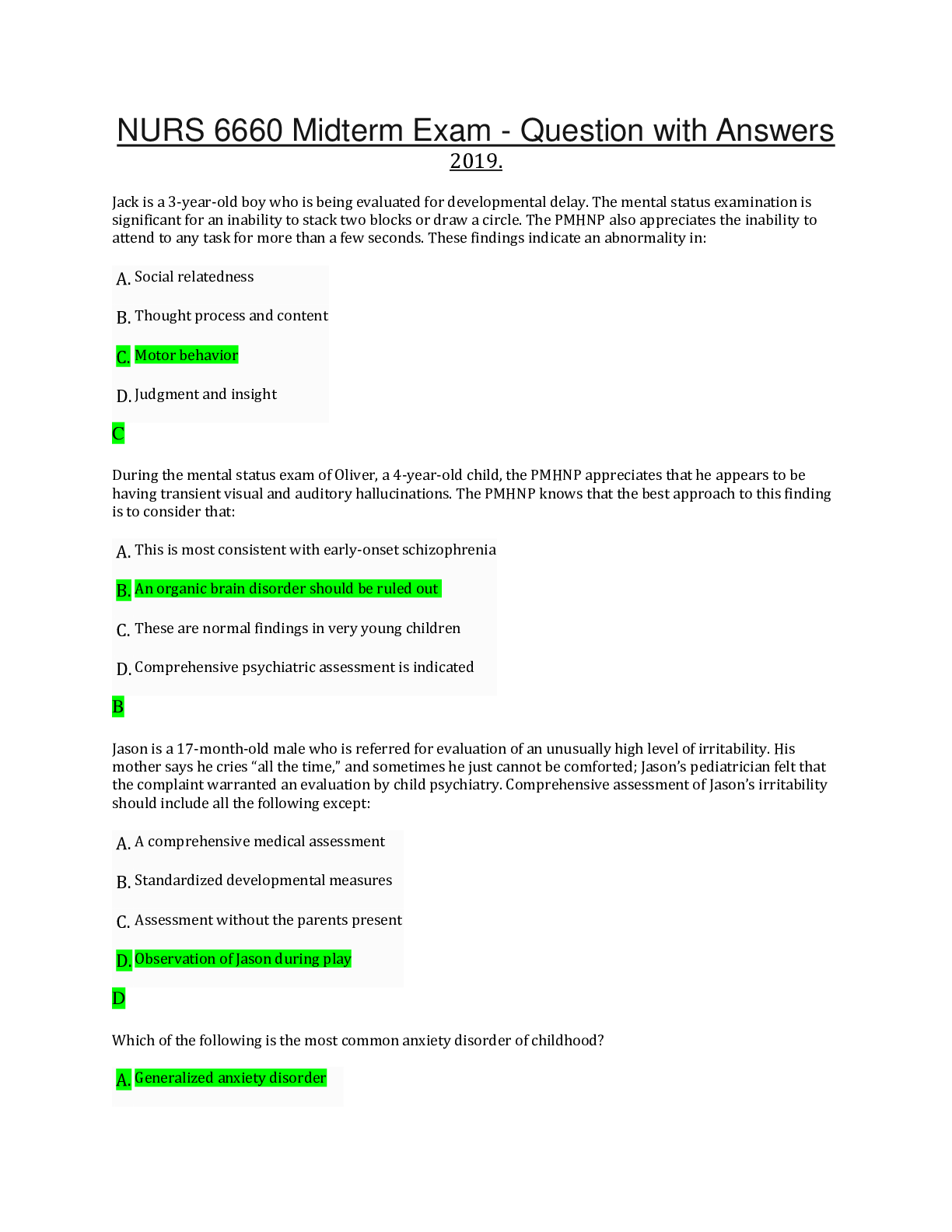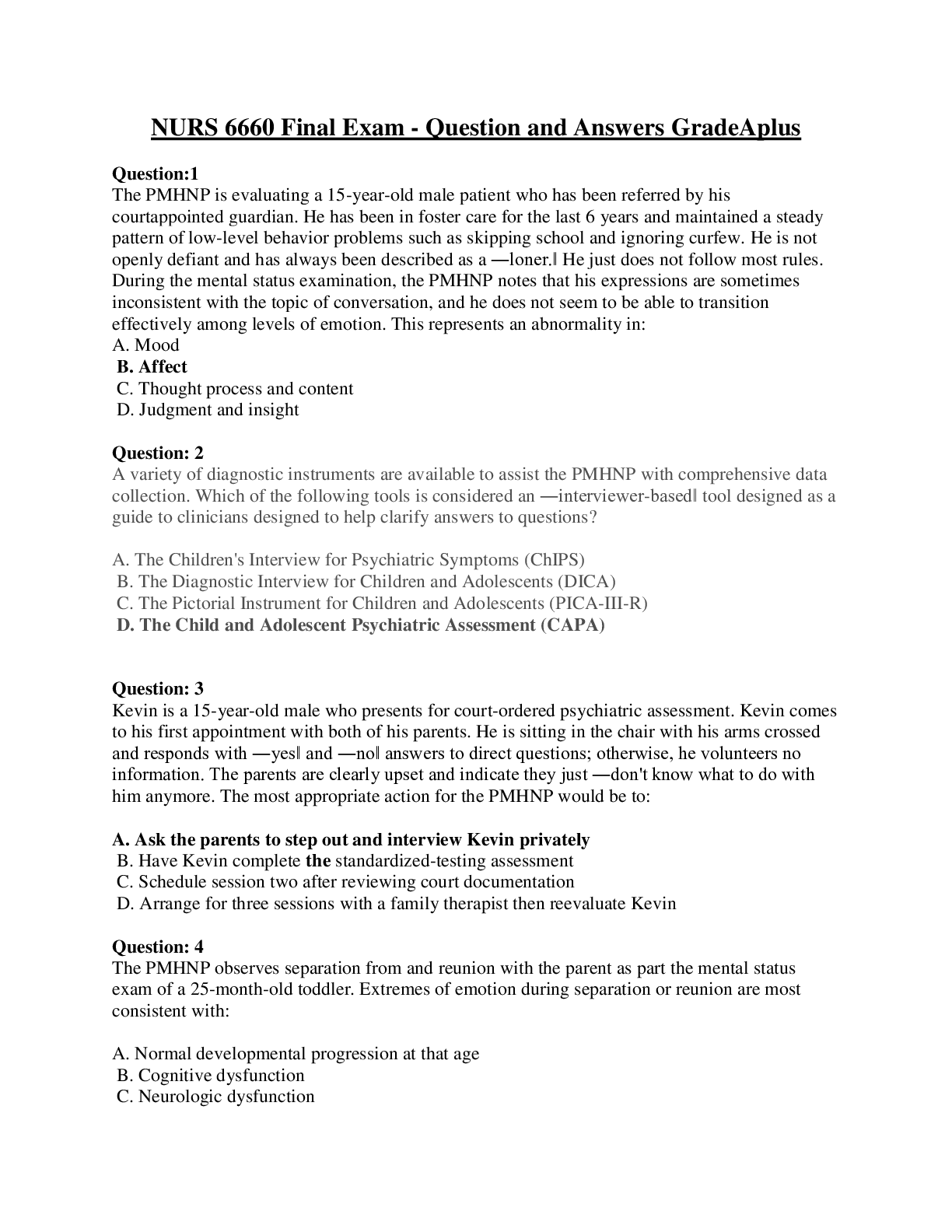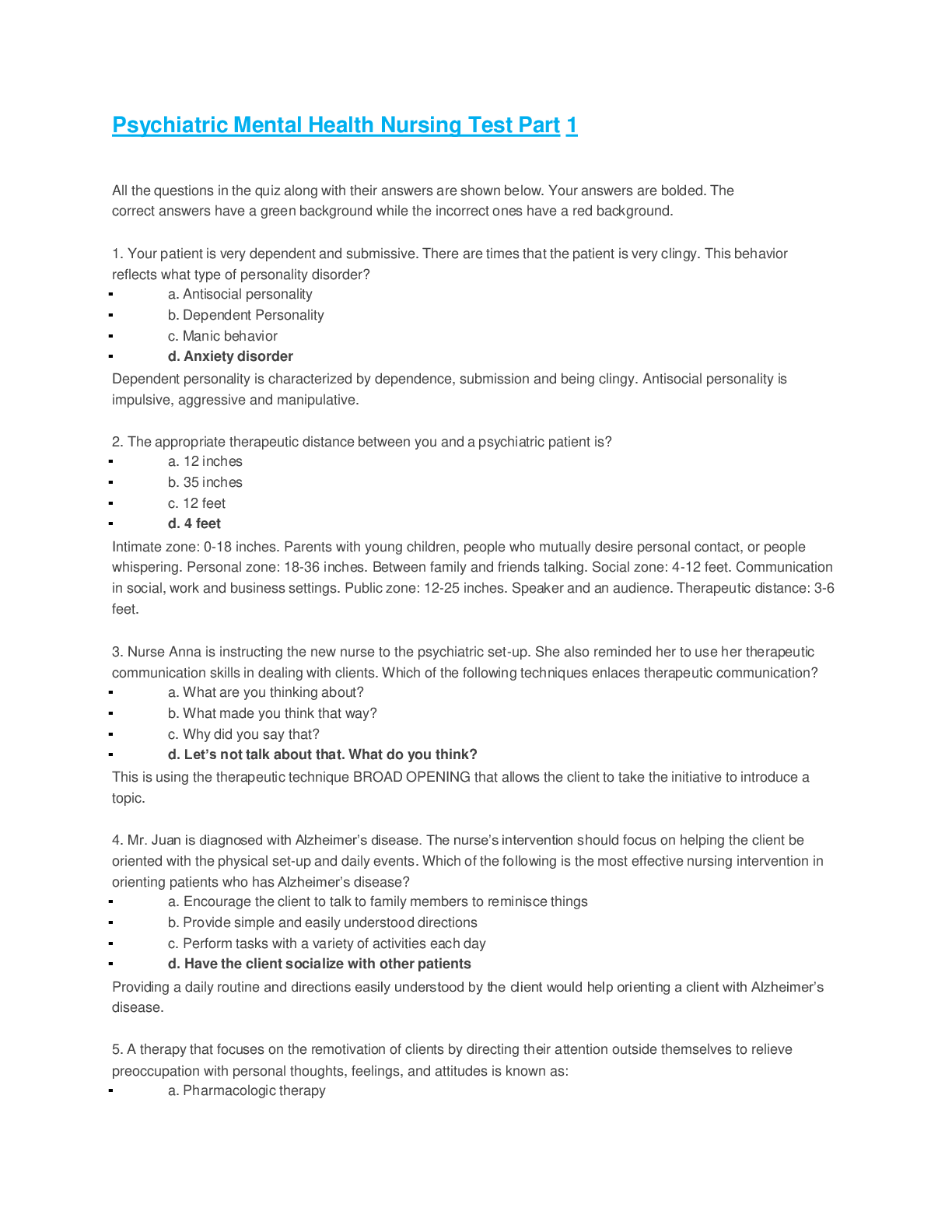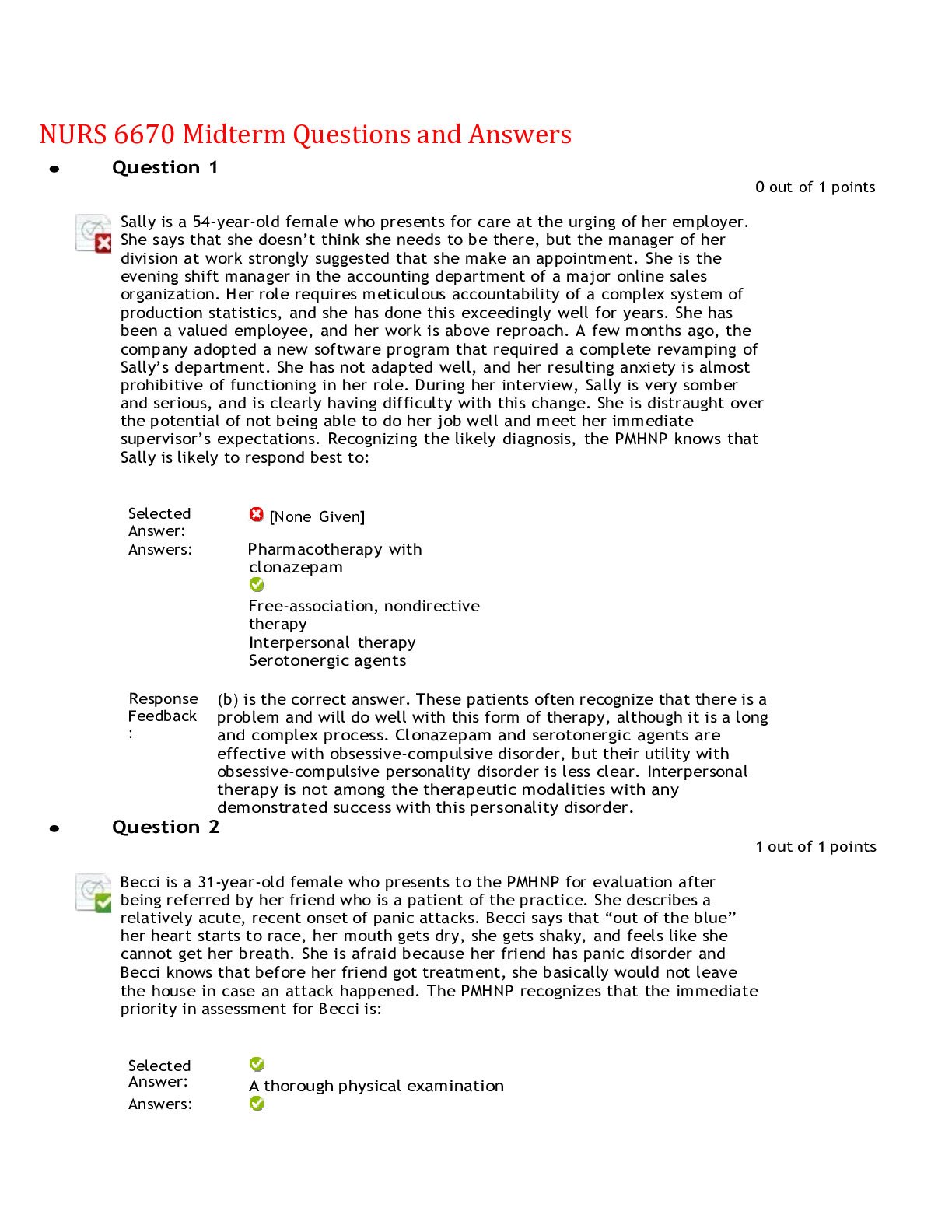Psychology > EXAM > PSY 209 Mohr: Psychiatric Mental Health Nursing, 6th Edition/PSY 209 Mohr Psychiatric Mental Health (All)
PSY 209 Mohr: Psychiatric Mental Health Nursing, 6th Edition/PSY 209 Mohr Psychiatric Mental Health Nursing, 6th Edition
Document Content and Description Below
PSY 209 Mohr: Psychiatric Mental Health Nursing, 6th Edition Chapter 1: Introduction to Psychiatric-Mental Health Nursing 1. A nurse is giving a presentation about preventing mental illness to col... lege freshmen. A student asks, “What does it mean to be mentally healthy?” Which of the following potential responses by the nurse is best? A) “Mental health is difficult to define and depends on cultural norms.” B) “Mental health is marked by productive, satisfying activity and fulfilling relationships.” C) “Mental health is the absence of mental illness.” D) “Mental health is defined as behavior accepted as normal by the major cultural group.” Ans: B Chapter: 01 Client Needs: B-2 Cognitive level: Knowledge Concepts & Processes: Self-care Difficulty: Easy Objective: 01 Feedback: Mental health is defined as the successful performance of mental function, resulting in productive activities, fulfilling relationships, and the ability to adapt to change and cope with adversity. Mental health provides people with the capacity for rational thinking, communication skills, learning, emotional growth, resilience, and self-esteem. People experiencing emotional well-being or mental health function comfortably in society and are satisfied with their achievements. 2. The document Mental Health: Report of the Surgeon General (1999) is significant because it A) states clearly that there are effective treatments for mental illness. B) allocates research money to psychiatric facilities. C) sets new guidelines for use of restraints. D) establishes reimbursement guidelines for third-party payers. Ans: A Chapter: 01 Client Needs: A-1 Cognitive level: Knowledge Concepts & Processes: DocumentationDifficulty: Moderate Objective: 02 Feedback: Mental Health: A Report of the Surgeon addressed that mental health is fundamental to and necessary for a healthy life; mental disorders are real health conditions with enormous consequences for individuals, families, communities, and the nation; effective treatments for mental disorders are available; a range of treatment options is available for most mental disorders; and those with mental disorders or symptoms should seek treatment. 3. A 48-year-old independent, successful woman is recovering from a modified radical mastectomy. She states she was grateful that during the first few weeks after surgery her mother stayed with her and did “everything” for her. Which element of mental health does this reflect? A) Stress management B) Mastery of the environment C) Self-governance D) Tolerance of uncertainty Ans: C Chapter: 01 Client Needs: C-1 Cognitive level: Comprehension Concepts & Processes: Caring Difficulty: Moderate Objective: 01 Feedback: In self-governance, the person acts independently, dependently, or interdependently as the need arises without permanently losing his or her autonomy. Tolerance of uncertainty means the person faces the uncertainty of life and the certainty of death with faith and hope. To master the environment, the person becomes competent, effective, and creative in interacting with and influencing his or her environment. Stress management involves the person experiencing appropriate emotions in daily life and tolerating stress, knowing that the feelings are not going to last forever. 4. The purpose of the five-axis system used in the fourth edition of the Diagnostic and Statistical Manual of Mental Disorders, text revision (DSM-IV-TR), is to A) separate the various mental disorders into five related categories. B) give a comprehensive picture of client functioning. C) improve prognostic ability. D) provide a decision-making algorithm for pharmacologic treatment. Ans: B Chapter: 01Client Needs: A-1 Cognitive level: Knowledge Concepts & Processes: Nursing process Difficulty: Moderate Objective: 03 Feedback: The categorical classification of the DSM-IV-TR uses a five-axis system to give a comprehensive picture of the client's functioning. 5. Which of the following represents a problem complicating the treatment of people with mental illness? A) Insurer's reimbursement decisions B) Increased responsibility for care by state mental hospitals C) Overuse of the well-coordinated mental healthcare system D) Lack of effective treatments Ans: A Chapter: 01 Client Needs: A-1 Cognitive level: Knowledge Concepts & Processes: Caring Difficulty: Moderate Objective: 04 Feedback: A goal of behavioral health-managed care has been to reduce hospital admissions, which are the most expensive part of psychiatric care. Unfortunately, some managed care “gatekeepers” have denied or restricted access to needed services and therefore have added to the discouragement, distress, and even despair of clients and their families. 3 6. A 22-year-old man with a history of a recent suicide attempt is being treated for depression. Prior to becoming depressed, the client attended a prestigious art school and enjoyed many social and leisure activities. Of the following long-term goals for this client, which is consistent with an overarching recovery goal for all clients with mental disorders? A) The client will not injure himself. B) The client's symptoms will be reduced. C) The client will show interest in social and leisure activities. D) The client will resume premorbid level of functioning. Ans: D Chapter: 01 Client Needs: C-2Cognitive level: Analysis Concepts & Processes: Nursing process Difficulty: Difficult Objective: 04 Feedback: The aim for mental health care is for clients to recover or to experience a remission of illness, that is, to become “well.” Full recovery means that clients are restored to their premorbid (“preillness”) psychosocial, educational, and occupational functioning. 6-17 7. Which of the following approaches to care best reflects cultural competence? A) Always assign nurses of a specific ethnic background to clients with the same ethnic background. B) Learn the behaviors and values associated with people of specific ethnic backgrounds. C) Assess the culturally mediated beliefs of each client. D) Believe that people are more alike than they are different. Ans: C Chapter: 01 Client Needs: C-1 Cognitive level: Comprehension Concepts & Processes: Cultural awareness Difficulty: Difficult Objective: 04 Feedback: Culturally competent care means that care is provided in a manner acceptable to the person's cultural background, regardless of whether it is provided by a care provider from the same ethnic or minority group as the client. Healthcare professionals must be able to incorporate cultural factors including language, customs, beliefs, and traditions into plans of care. 8 8. The family advocacy movement and NAMI: the Nation's Voice on Mental Illness has identified stages through which families progress when confronting the mental illness of a loved one. Which of the following accurately reflects the stages identified in the Family Advocacy Model? A) Dealing with a catastrophic event, learning to cope, moving into advocacy B) Learning acceptance, experiencing grief, developing advocacy C) Beginning recognition, denial, grief, acceptance, advocacy D) Learning to cope, understanding, advocating Ans: A Chapter: 01Client Needs: C-1 Cognitive level: Knowledge Concepts & Processes: Self-care Difficulty: Difficult Objective: 05 Feedback: Initially, when dealing with the catastrophic event, the family is overwhelmed, confused, and lost. They then learn to cope and realize the illness is a reality. The family often expresses grief, fear, and sorrow over lost possibilities and the uncertain future. Finally, moving into advocacy is evidenced when family members develop empathy, acknowledge and own the situation, and focus anger and grief on empowerment. 9. Which of the following interventions is appropriate for a psychiatric-mental health nurse at the basic level of practice? A) Case management B) Managing psychotropic medications C) Conducting family therapy D) Interpreting laboratory tests Ans: A Chapter: 01 Client Needs: A-1 Cognitive level: Knowledge Concepts & Processes: Nursing process Difficulty: Moderate Objective: 06 Feedback: At the basic level of practice, psychiatric-mental health nurses assess biopsychosocial functioning, serve as case managers, design therapeutic environments, and promote self-care activities, including medication and symptom management. They educate clients and families about health, illness, and treatment; provide supportive counseling; intervene in crises; and promote psychiatric rehabilitation. At the advanced level of practice, psychiatric-mental health nurses deliver comprehensive primary mental healthcare services to clients through health teaching and screening, performing preventive interventions, and evaluating and managing care for people with mental illness. 10. An adolescent has a history of self-mutilation. The nurse questions the client about her behavior. The nurse's questioning reflects the principle that A) every person deserves respect. B) all people share basic human needs. C) through the therapeutic use of self, nurses can help people adapt, change, and grow. D) all behavior is meaningful and can be understood from the person's perspective.Ans: D Chapter: 01 Client Needs: B-2 Cognitive level: Application Concepts & Processes: Caring Difficulty: Difficult Objective: 07 Feedback: Psychiatric-mental health nursing is built on certain principles or beliefs about people and the care they deserve: Every person is worthy of dignity and respect; every person has the potential to change and grow; all people share basic human needs; all behavior is meaningful and can be understood from the person's perspective; people have the right to participate in decisions affecting their health and treatment. Through the therapeutic use of self, via therapeutic relationships and communication, nurses help people adapt, change, and grow. While all the above principles are followed, the nurse's questioning in the stem best reflects the principle that all behavior has meaning and can be understood from the person's perspective. 11. A 44-year-old client with a history of alcohol abuse and schizophrenia is being treated as an outpatient. He is living in a group home, has been stable for several months, is not abusing alcohol, and is not experiencing delusions or auditory hallucinations. Which of the following interventions most appropriately includes the client in decisions about his treatment? A) Suggest the client decide whether to take his medication, based on his symptoms. B) Include the client in developing a treatment plan in case he becomes acutely psychotic in the future. C) Agree with the client's suggestion that he terminate treatment and call if he experiences a relapse. D) Encourage the client to make a decision about living independently. Ans: B Chapter: 01 Client Needs: A-1 Cognitive level: Application Concepts & Processes: Teaching/learning Difficulty: Moderate Objective: 07 Feedback: The nurse is a member of an interdisciplinary team. The team also includes the client and his or her family. Collaboration implies that members work toward a common goal and share responsibility for the outcomes of care. 12. The legal system orders a client with antisocial personality disorder into treatment. He has ahistory of spousal abuse and multiple arrests and convictions for drug trafficking. The nurse meets with the client, performs a quick assessment, and gives him information about the anger management classes he is mandated to attend. The nurse's brief visit and superficial intervention are A) appropriate, because clients with antisocial personality disorder resist treatment. B) appropriate, because the client is not in treatment willingly. C) inappropriate, because all people have the potential to change and grow. D) inappropriate, because the nurse did not address the client's history of drug abuse. Ans: C Chapter: 01 Client Needs: A-1 Cognitive level: Interpretation Concepts & Processes: Caring Difficulty: Moderate Objective: 07 Feedback: Psychiatric-mental health nursing is built on certain principles or beliefs about people and the care they deserve: Every person is worthy of dignity and respect; every person has the potential to change and grow; all people share basic human needs; all behavior is meaningful and can be understood from the person's perspective; people have the right to participate in decisions affecting their health and treatment; and through the therapeutic use of self, via therapeutic relationships and communication, nurses help people adapt, change, and grow. 13. The main tool at the nurse's disposal in treating clients with mental disorders is A) psychotropic medications. B) the therapeutic use of self. C) self-help groups. D) family education and therapy. Ans: B Chapter: 01 Client Needs: C-1 Cognitive level: Knowledge Concepts & Processes: Nursing process Difficulty: Moderate Objective: 07 Feedback: Through the therapeutic use of self, via therapeutic relationships and communication, nurses help people adapt, change, and grow. Medications and education will influence and enhance growth, but the therapeutic use of self is the nurse's primary tool. Self-help groups do not involve healthcare professionals.14. Mark, a staff nurse at a psychiatric facility, has spent many hours working with a client and becomes angry during a care conference when another nurse, Janet, suggests he is becoming overly involved with the client. Mark ignores Janet's requests for a meeting, then agrees to attend one, but does not show up. Mark's failure to go to the meeting is an example of A) horizontal violence. B) burnout. C) passive-aggressive behavior. D) selective forgetfulness. Ans: C Chapter: 01 Client Needs: A-1 Cognitive level: Interpretation Concepts & Processes: Caring Difficulty: Moderate Objective: 08 Feedback: Passive-aggressive behavior undermines the effectiveness of other nurses' work. An example of passive-aggressive behavior is when a nurse resists requests for adequate daily performance but expresses this resistance “indirectly” through procrastination, calling in sick, dawdling, intentional inefficiency, or “forgetfulness.” Horizontal violence involves anger or negativity a nurse directs at another nurse. Other warning signs of burnout are loss of energy and enthusiasm, fatigue, insomnia, and alcohol and drug use. 15. One way psychiatric-mental health nurses can help prevent burnout is to A) refuse to accept responsibility for other people's problems. B) avoid other staff who are negative or toxic. C) accept that it is not usually possible to give high-quality care. D) acknowledge that anger and frustration are part of the job. Ans: A Chapter: 01 Client Needs: A-1 Cognitive level: Interpretation Concepts & Processes: Self-care Difficulty: Moderate Objective: 08 Feedback: To stay healthy and happy, nurses should refuse to accept responsibility for others' problems, manage client care according to priorities, keep priorities for family, friends, and personal goals in order, search for creative ways to express excellence at work, and never stop learning. Support systems at home and work allow nurses to express feelings and keep situations in perspective. Nurses need to cultivate realistic expectations from the job and from themselves. [Show More]
Last updated: 1 year ago
Preview 1 out of 9 pages
Instant download

Buy this document to get the full access instantly
Instant Download Access after purchase
Add to cartInstant download
Reviews( 0 )
Document information
Connected school, study & course
About the document
Uploaded On
May 14, 2021
Number of pages
9
Written in
Additional information
This document has been written for:
Uploaded
May 14, 2021
Downloads
0
Views
41

